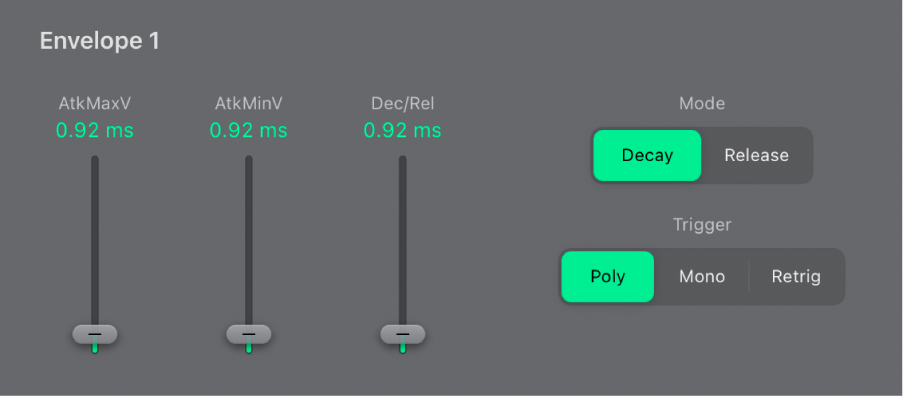Logic Pro User Guide for iPad
- What’s new in Logic Pro 1.1
-
- What is Logic Pro?
- Working areas
- Work with function buttons
- Work with numeric values
-
- Intro to tracks
- Create tracks
- Create tracks using drag and drop
- Choose the default region type for a software instrument track
- Select tracks
- Duplicate tracks
- Reorder tracks
- Rename tracks
- Change track icons
- Change track colors
- Use the tuner on an audio track
- Show the output track in the Tracks area
- Delete tracks
- Edit track parameters
- Start a Logic Pro subscription
- How to get help
-
- Intro to recording
-
- Before recording software instruments
- Record software instruments
- Record additional software instrument takes
- Record to multiple software instrument tracks
- Record multiple MIDI devices to multiple tracks
- Record software instruments and audio simultaneously
- Merge software instrument recordings
- Spot erase software instrument recordings
- Replace software instrument recordings
- Capture your most recent MIDI performance
- Use the metronome
- Use the count-in
-
- Intro to arranging
-
- Intro to regions
- Select regions
- Cut, copy, and paste regions
- Move regions
- Remove gaps between regions
- Delay region playback
- Trim regions
- Loop regions
- Repeat regions
- Mute regions
- Split and join regions
- Stretch regions
- Separate a MIDI region by note pitch
- Bounce regions in place
- Change the gain of audio regions
- Create regions in the Tracks area
- Convert a MIDI region to a Drummer region or a pattern region
- Rename regions
- Change the color of regions
- Delete regions
- Create fades on audio regions
- Access mixing functions using the Fader
-
- Intro to Step Sequencer
- Use Step Sequencer with Drum Machine Designer
- Record Step Sequencer patterns live
- Step record Step Sequencer patterns
- Load and save patterns
- Modify pattern playback
- Edit steps
- Edit rows
- Edit Step Sequencer pattern, row, and step settings in the inspector
- Customize Step Sequencer
-
- Effect plug-ins overview
-
- Instrument plug-ins overview
-
- ES2 overview
- Interface overview
-
- Modulation overview
-
- Vector Envelope overview
- Use Vector Envelope points
- Use Vector Envelope solo and sustain points
- Set Vector Envelope segment times
- Vector Envelope XY pad controls
- Vector Envelope Actions menu
- Vector Envelope loop controls
- Vector Envelope release phase behavior
- Vector Envelope point transition shapes
- Use Vector Envelope time scaling
- Use the Mod Pad
- Modulation source reference
- Via modulation source reference
-
- Sample Alchemy overview
- Interface overview
- Add source material
- Save a preset
- Edit mode
- Play modes
- Source overview
- Synthesis modes
- Granular controls
- Additive effects
- Additive effect controls
- Spectral effect
- Spectral effect controls
- Filter module
- Low and highpass filter
- Comb PM filter
- Downsampler filter
- FM filter
- Envelope generators
- Mod Matrix
- Modulation routing
- Motion mode
- Trim mode
- More menu
- Sampler
- Copyright
ES2 Envelope 1 in Logic Pro for iPad
Although Envelope 1 appears to be simplistic, it is useful for a range of synthesizer functions.

ES2 Envelope 1 parameters
Attack via Velocity Min/Max sliders: Move the left slider (AtkMaxV) to set the attack time when keys are struck at maximum velocity. The right slider (AtkMinV) sets the attack time at minimum velocity.
Dec/Rel slider and field: Set the decay time when the Decay button is active. Set the time required for the level to decrease to zero once the key is released, when the Release button is active.
Mode buttons: Tap to switch Envelope 1 between an Attack/Decay or an Attack/Release envelope.
Decay mode: The level falls to zero after the attack phase has completed, whether or not the note is sustained. It decays at the same speed, even if you release the key. Set the decay time with the Dec/Rel slider.
Release mode: The envelope level remains at its maximum after the attack phase is over, while the key remains depressed. Use the Dec/Rel slider to set the time required for the level to fall to zero, once the key is released.
Trigger buttons: Choose a mode to define the trigger behavior of Envelope 1.
Poly: The envelope generator behaves as you would expect on any polyphonic synthesizer: every voice has its own envelope.
Mono: A single envelope generator modulates all voices in the same way. All notes must be released before the envelope can be retriggered. If you play legato, or any key remains depressed, the envelope does not restart its attack phase.
Retrig: A single envelope generator modulates all voices in the same way. The envelope is triggered by any key you strike, even when other notes are sustained. All sustained notes are identically affected by the retriggered envelope.
Download this guide: PDF